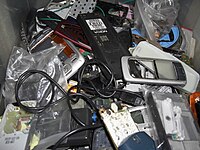
Photo from wikipedia
Newborns in high-income countries are routinely screened for neonatal jaundice using transcutaneous bilirubinometery (TcB). In low-and middle-income countries, TcB is not widely used due to a lack of availability; however,… Click to show full abstract
Newborns in high-income countries are routinely screened for neonatal jaundice using transcutaneous bilirubinometery (TcB). In low-and middle-income countries, TcB is not widely used due to a lack of availability; however, mobile-phone approaches for TcB could help expand screening opportunities. We developed a mobile phone-based approach for TcB and validated the method with a 37 patient multi-ethnic pilot study. We include a custom-designed snap-on adapter that is used to create a spatially resolved diffuse reflectance detection configuration with the illumination provided by the mobile-phone LED flash. Monte-Carlo models of reflectance from neonatal skin were used to guide the design of an adapter for filtered red-green-blue (RGB) mobile-phone camera reflectance measurements. We extracted measures of reflectance from multiple optimized spatial-offset regions-of-interest (ROIs) and a linear model was developed and cross-validated. This resulted in a correlation between total serum bilirubin and mobile-phone TcB estimated bilirubin with a R2= 0.42 and Bland-Altman limits of agreement of +6.4 mg/dL to -7.0 mg/dL. These results indicate that a mobile phone with a modified adapter can be utilized to measure neonatal bilirubin values, thus creating a novel tool for neonatal jaundice screening in low-resource settings.
Journal Title: Biomedical Optics Express
Year Published: 2022
Link to full text (if available)
Share on Social Media: Sign Up to like & get
recommendations!